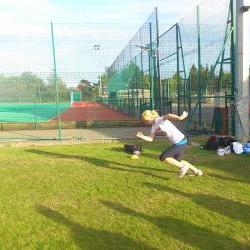How can I sprint quicker?
Speed kills…
Almost every athlete needs to sprint quickly in their sport, those who do it quicker, beat their opponents. Putting aside the need for braking and change of direction, pure sprint speed is a useful asset.
Before working on these aspects, we always make sure that the foundation movement patterns and underlying structural integrity are in place. Otherwise, you simply can’t progress as quickly.
The two key parts to running faster
 Acceleration:
Acceleration:
the start phase which requires the ability to apply great force and the ability to hold Straight Line Extension (SLX). This can be improved through strength training and correct technique (more detail here)
Running Technique:
Once you are upright, then running technique is very important. Athletes broadly fall into either those with good co-ordination (fluidity?) but need strengthening, or those who are strong, but lack co-ordination.
Sprinting technique can be improved. As part of the Sports Training System we offer more detail, with video clips.
The top 7 technical running points
- Brief surface contact: Run in the air, not on the ground. When landing, think of a short sharp tick.
- Small range for leg movement: A smaller range will conserve energy. A more efficient action is when the rear leg doesn’t move too far backward and the front leg isn’t lifted too high.
- Holding the trunk upright: Keep the hips directly under the shoulders with the back held stretched. This helps the abdominal muscles work and stops over rotation of the shoulders.
- Keeping the foot in as neutral a position as possible: A 90 degree angle at the ankle joint is optimal. Get this as soon after push off as possible and maintain until you land at the front.
- Optimal arm action: A greater backward swing than forward swing is optimal. The elbow should drive back to the rear and upwards in time with the scissor leg action.
- Optimal vertical displacement: It sounds strange, but a higher vertical displacement (without long ground contact time) leads to longer flight time and faster running.
- Rapid linear pendular motion of the swing leg: After push off, the leg should be brought rapidly forward as linearly as possible. This means hip and knee bend together. Rather than the heel kicking up towards your bum.
Our goal is to make everyone faster: the underlying principles are universal, but we apply them to each individual and sport differently. Speed training for running also needs strengthening exercises. The training for running speed is itself strenuous, especially for non athletes.
Do you want to run faster too? Then click here.
(Technical aspects taken from Frans Bosch)

[…] sprinting and changing direction are all general motor skills which need a variety of training methods to […]
[…] plan all year round, and should consist of exercises to help improve top speed through correct running mechanics. The volume of this work can then be increased (when suitable) to provide the endurance of the […]
[…] these past few sessions, we have been looking at running techniques with some of the athletes. The aim is to run efficiently. I watched a DVD by Frans Bosch that James […]
[…] will involve training straight line speed to improve the ability to run faster as well as agility to change direction at […]
[…] (For running technique tips see here) […]
[…] spent some time going through agility progressions and the 7 steps to running faster with the […]
[…] of this was accompanied by practical work on how to run correctly, what golfers should eat for breakfast, and examples of stretching routines for […]
[…] Blindingly obvious when I thought about it. I had been working on the overall sprint mechanics but had been distracted by the […]
[…] Speed […]
[…] court are 32 ft (9.75 m) long and 21 feet (6.4 m) wide and therefore in terms of speed the acceleration is very […]
[…] How can I sprint quicker?: 7 key areas to work on. […]